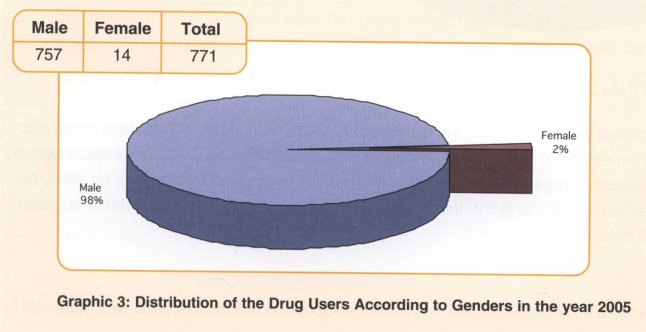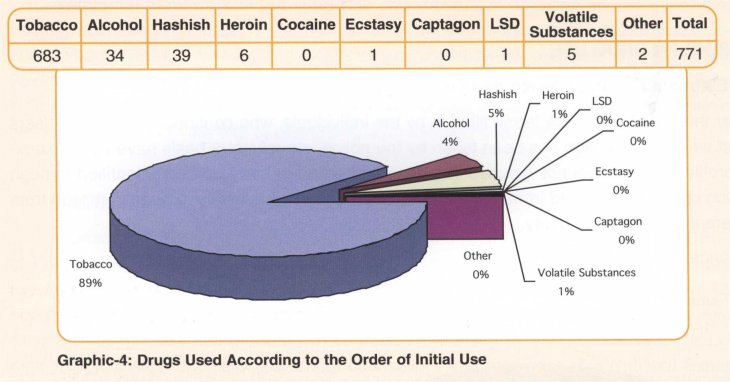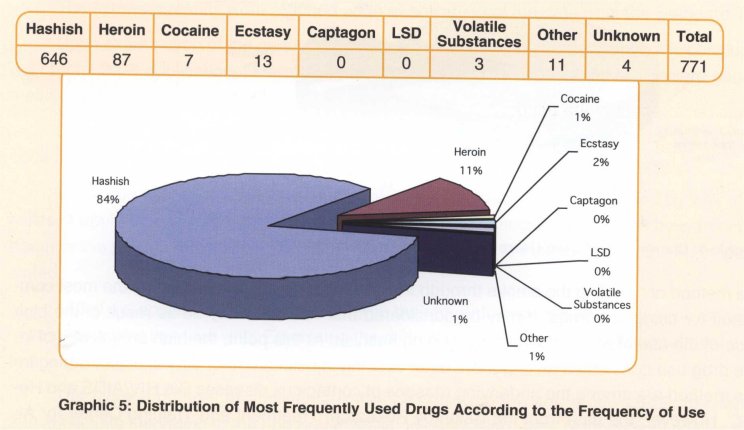4. PROBLEM DRUG USE
| Reports - National Report Turkey 2006 |
Drug Abuse
4. PROBLEM DRUG USE
4.1. Estimation of Prevalence and Frequency
Under this subheading, the forms filled in by the individuals, who confirmed being drug users and against whom legal action has been taken by the police, on voluntary basis have been exami-ned. The profile of drug users not included in a treatment program has also been identified through interpretation of the data derived from these forms. The forms in question have been compiled from the 81 different provinces in Turkey.
1. Gender

The distribution of the drug users according to the genders is demonstrated in Graphic 3. The graphic shows that 98°/0 of the drug users are male, whereas 2°/0 are female. The reason for the low prevalence of drug use among female is that tendency to use drugs is lower among female in the Turkish society due to social reasons; use of illegal drugs in the society in general is regarded as dangerous due to the addiction risk it poses and the legal actions it entails and thus female ha-ve a tendency to consume less alcohol and drugs in socio-cultural terms and they do not engage in trade or use of illegal drugs. In terms of drug use; it is deemed that female engage in misuse of ethical medicines; but they are unaware of the situation or have a sort of addiction they do not over-rate.
More involvement of the men in environments related to drugs lies in the social roles rather than the biological effect of the gender.'
2-Drugs Used According to the Order of Initial Use

Examining the drugs used according to the order of initial use; one can think that these data reveal the transitions experienced specifically in drug use. In the ranking made by drug users accor-ding to initial use of various drugs, it is concluded that the first drug used is cigarette by 89°/0, se-cond drug used is hashish by 5`)/0 and the third one is alcohol by 4°/0. Heroin and volatile substan-ces fall under the 1% category.
The data provided in the survey demonstrates that most drug users start smoking before they start using narcotic drugs. It is possible say that cigarette and alcohol are precursors in the initial use of other addictive and illegal drugs; those who do not smoke or drink alcohol are away from ad-diction when compared with those who do; the social environment and the lives shared are thus se-parated from each other.
3- Drugs According to Frequency of Use (Most Frequently Used Drugs)

In view of the frequency of use; the most frequently used drug among the drugs used most frequently is Hashish by 84`)/0, which is followed by Heroin by 11%, Ecstasy by 2°/0 and other drugs.
It is reported in many studies conducted in Turkey that hashish is the most frequently used drug. Such high frequency of hashish use is deemed to be resulting from the relatively easier ac-cess and supply of the drug, underestimation of its probable harms and the drug being considered more acceptable in social terms compared with other drugs.2
4- Method for Use of the Drug

The method of "inhaling the smoke through the respiratory tract" is regarded as the most com-mon method for using the drugs. It may be considered that this data may be as result of the high prevalence of the use of rolled cigarette containing hashish. At this point, the high prevalence of in-travenous drug use constitutes an important data. Sharing injectors, use of dirty injectors during in-travenous method are among the underlying reasons of contagious diseases like HIV/AIDS and He-patitis B-C. However, the data from the Bakirk4 Research, Treatment and Training Center for Al-cohol and Drug Addiction (AMATEM) demonstrates that there is a decrease in treatment demands for heroin addiction and that it is deemed too early to implement general harm reduction policies.
4.2. Treatment Demand Indicators
4.2.1. Profile of Drug Users under Treatment
Data from 9 of the 12 registered treatment centres were collected in the year 2004. As a re-sult of the works carried out. The number of centres complying with the standards reached 15, whe-reas the number of centres from which data may be collected reached 11 in the year 2005. In the year 2005, data on the patients who applied for treatment or were hospitalized for treatment were collected from 11 of the 15 centres in operation (Standard Table 24).
The data collected reveal that 2078 patients in total applied to these centres throughout the year 2005. 28.3`)/0 of all the applications were made to Istanbul AMATEM, 26.9% to Balikli Rum Hos-pital, 15.9°/0 to Ankara AMATEM, 10.3% to Elazig AMATEM, 8.1% to Adana AMATEM, 5.9% to Ma-nisa AMATEM, 1.6% to Samsun AMATEM, 1.3°/o to Ege University, Faculty of Medicine Hospital, 0.63/0 to Ankara University, Faculty of Medicine, 0.6°/0 to Istanbul University, Istanbul Faculty of Me-dicine and 0.5% to Denizli State Hospital.
The following results were reached upon examination of the data from the Standard Table 34.
Upon examination of the genders of the drug users applying for treatment; it is concluded that, out of total 2078 applications, there are 1895 men, 151 women and 32 did not declare gender. The mean age of the whole sample community is estimated to be 30,05.
Out of total 2078 applicants, 941 stated they were undergoing treatment for the first time and 1084 underwent treatment in the past. The statuses of 53 applicants are unknown.
1265 drug users applied to the treatment centres on their own, 687 applied by way of their fa-milies, 4 applied by way of their family doctors, 39 by way of social services, 18 by way of court de-cision or the police, 35 by other means and 30 were brought to the treatment centres by people not stated.
186 of the applicants live alone, 1776 with their parents and 28 with their friends. 85 applicants did not state who they live with. Examining the distribution of those applying for treatment according to age ,groups;
The highest number of applicants is 498 belonging to the age group 25-29, followed by the 380 applicants belonging to the age group 30-34. In conclusion, 42`)/0 of those applying for treatment fall under the age group of 25-34.
Upon examination of the places of living; 1993 of the applicants have a permanent place for living; 13 do not have a permanent place; 16 live in institutional settings (prison, clinic). Statuses of the 56 applicants are unknown.
Upon examination of the jobs held by those applying for treatment, it is concluded that 650 ha-ve regular employment, 59 are students, 39 are not active in economic terms, 1218 are unemplo-yed, 27 engage in other jobs. The jobs of 85 applicants are unknown.
Upon examination of the education status, it is concluded that 63 of the applicants have ne-ver attended school or did not graduate from primary school, 1279 are graduates of primary scho-ol, 554 have education at secondary school level, and 141 are university graduates. Education sta-tuses of 41 are unknown.
According to the drugs used; 998 of the applicants use heroin, one uses methadone, 38 use opiates, 76 use cocaine, one uses amphetamine, 11 use MDMA and other derivatives, 65 use ben-zodiazepines, 274 are volatile substance users, 462 use hashish, 29 use other drugs. The drugs used by 29 of the applicants are unknown.
Considering the methods for drug use; 622 of the users use intravenous method, 712 sniff the drug, 505 smoke, 246 eat/drink, 40 use other methods and there is no information regarding the method used by 43 of the users.3
Upon research of the frequency of drug use, it was found that out of 1029 applicants using opiates, 697 used it on a daily basis, 35 used 2-6 days in a week, 19 used once in a week or less, 6 did not use in the previous month and there was no information on frequency of drug use of 2 app-licants. Out of 75 applicants using cocaine; it was found that 48 used on a daily basis, 19 used 2-6 days a week, 2 used once a week or less and 6 did not use in the previous month. Out of 104 app-licants using MDMA and derivatives, it was found that 57 used on a daily basis, 31 used 2-6 days a week, 13 used once a week or less and 2 did not use in the previous month. The status of one of the applicants is unknown. One amphetamine user stated he/she used it on a daily basis. Out of 65 applicants using hypnotics and sedatives; it was found that 48 used on a daily basis, 11 used 2-6 days a week, 3 used once a week or less and 3 did not use in the previous month. Out of 274 app-licants using volatile substances; it was found that 191 used them on a daily basis, 50 used 2-6 days a week, 22 used once a week or less and 11 did not use in the previous month. Out of 451 appli-cants using volatile substances; it was found that 310 used them on a daily basis, 85 used 2-6 days a week, 27 used once a week or less and 26 did not use in the previous month. There is no infor-mation about 79 users in this part.
271 of those applying for treatment were younger than 15 years of age, 654 were between the ages 15-19, 526 between 20-24, 238 between 25-29, 162 between 30-34, 76 between 35-39, 39 between 40-44, 28 between 45-49, 7 between 50-54, 5 between 55-59, 2 between 60-64.
49 heroin users stated they used cocaine as a second drug, whereas 373 stated they used. 35 cocaine users stated they used hashish as the second drug. 56 MDMA users stated they used hashish as the second drug, 14 used hypnotics and sedatives, whereas 21 hashish users stated they used opiates as the second drug.
In terms of intravenous drug use; 163 stated they used intravenous method in the past, 549 stated they were still using it and 1260 stated they never used intravenous method.
1 Berna ULU6, Psychiatry Basic Book, Substance Use Related Disorders, Doctors' Assocation Press, 1997; page 303
2 Published report of the Association of Psychologists, 2002
3 Injection is an advanced stage of drug use and it is seen that most of those applying for treatment use injection. This sit-uation reveals the situation of the patients rather than the general situation of the country.
| < Prev | Next > |
|---|












